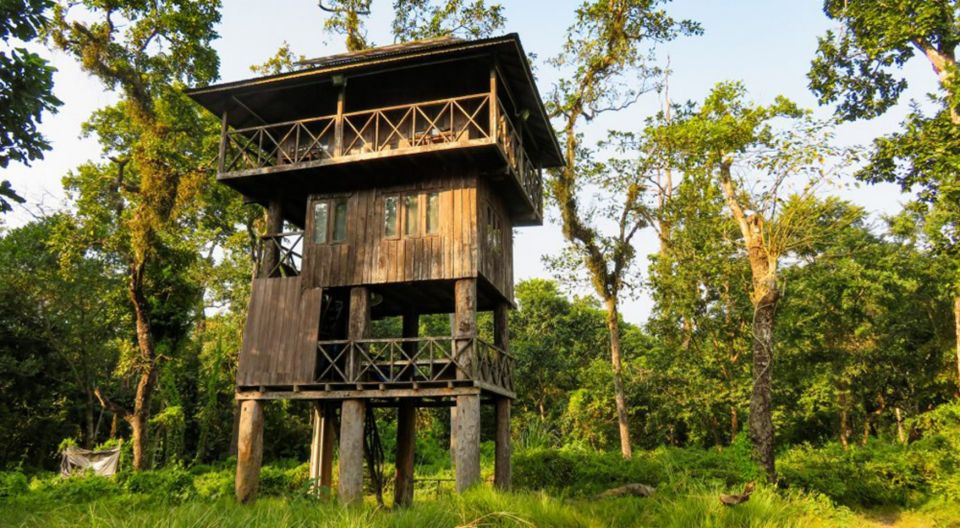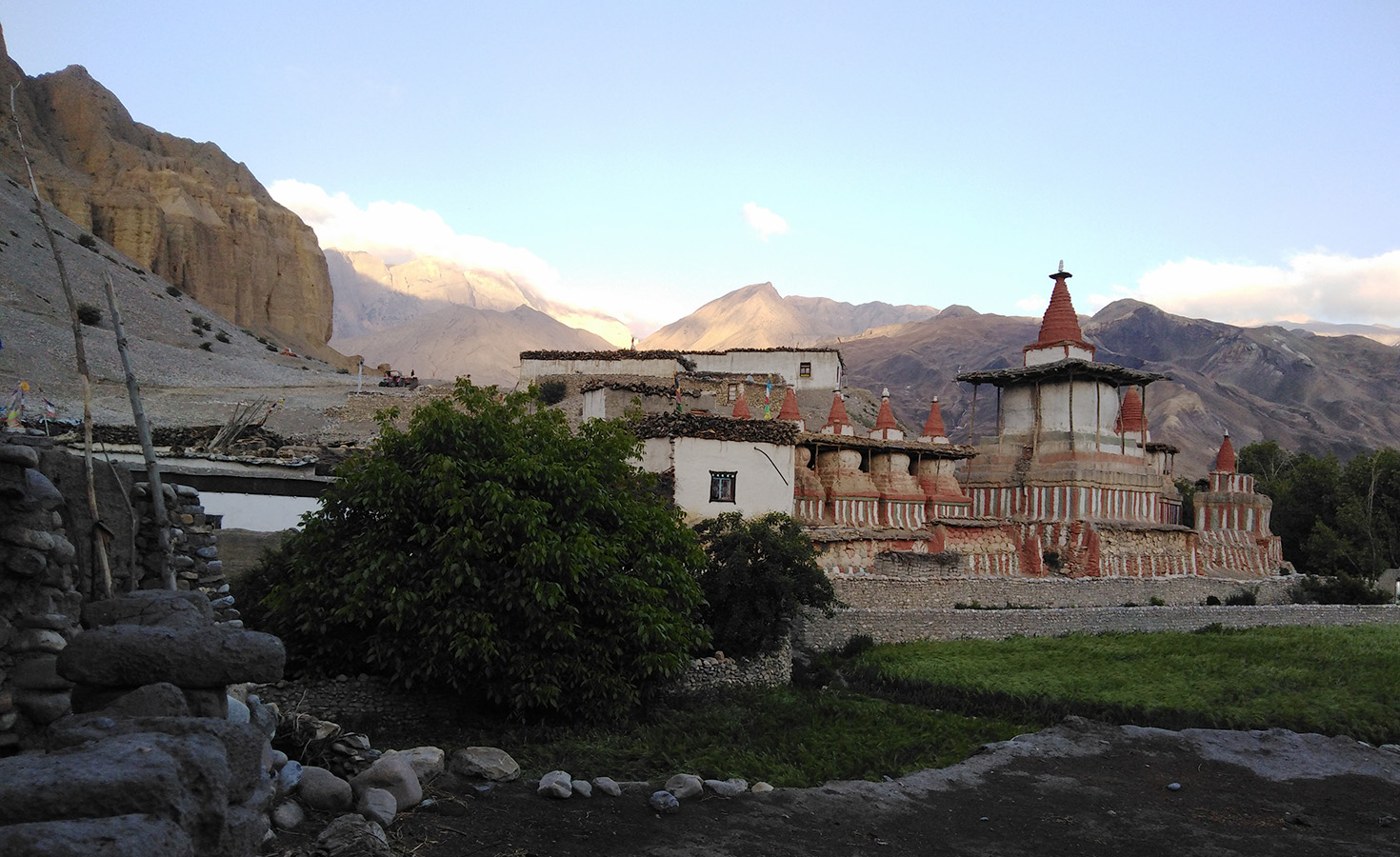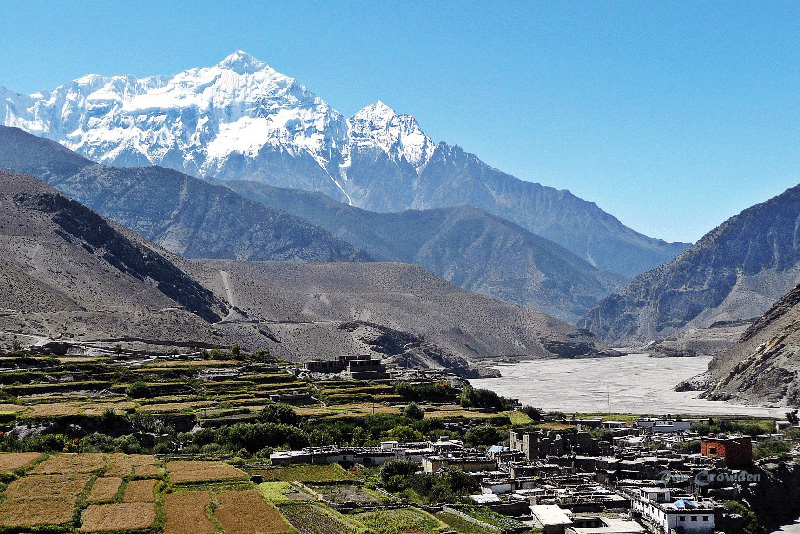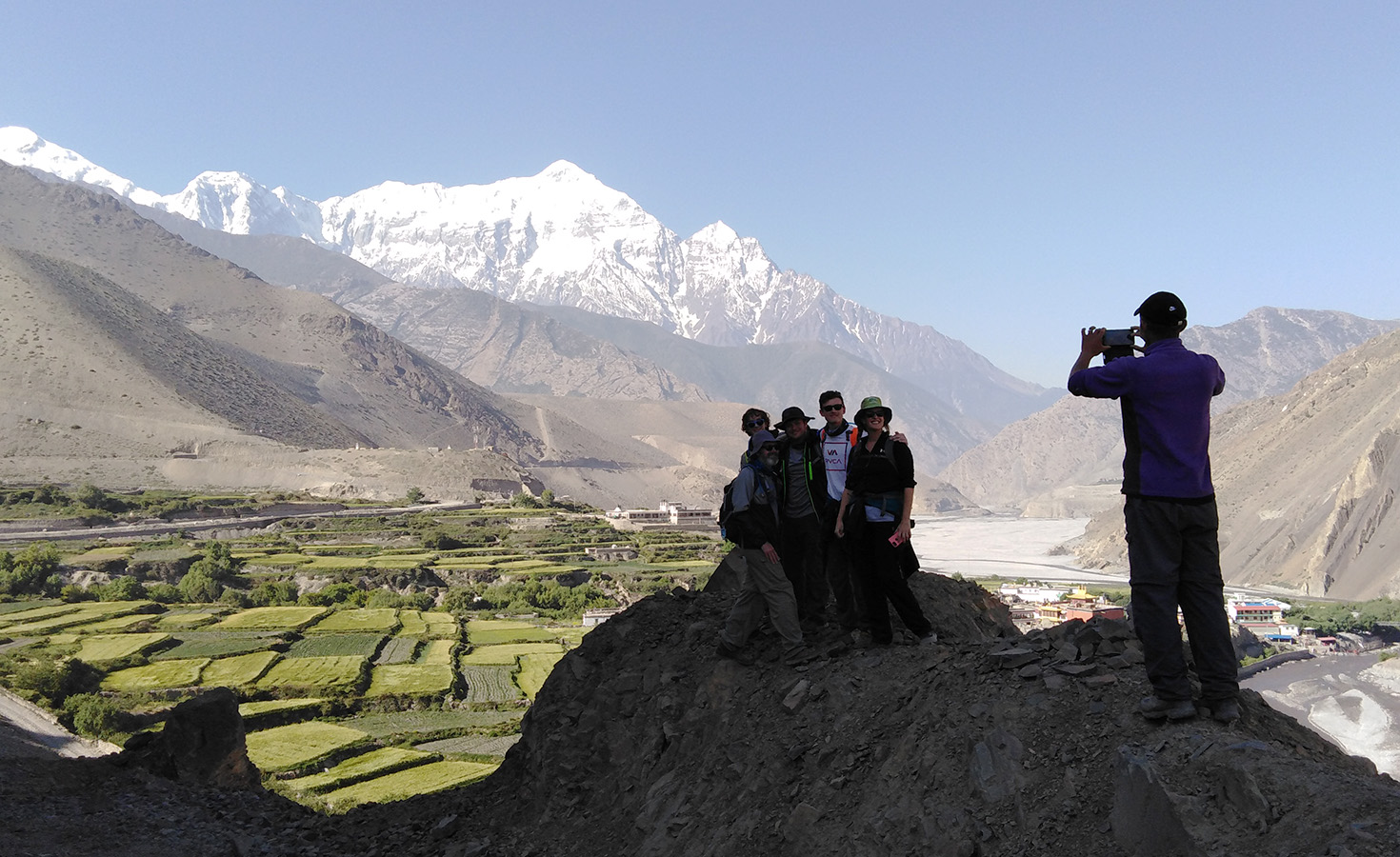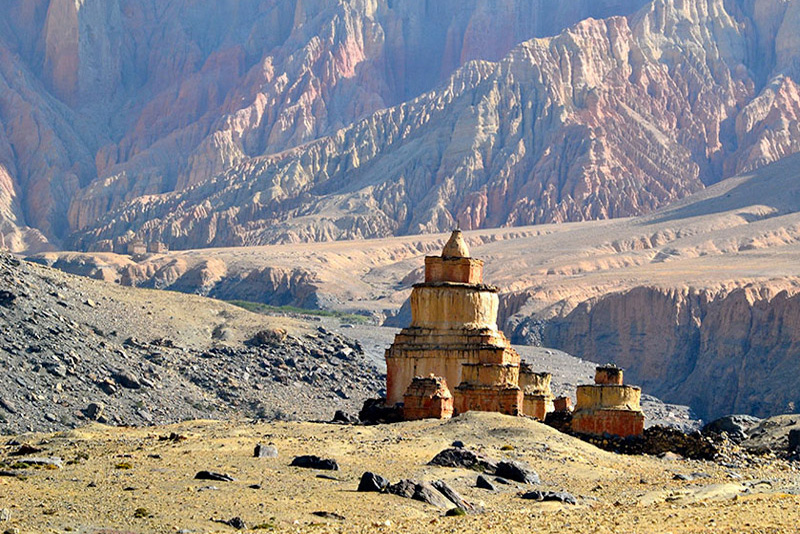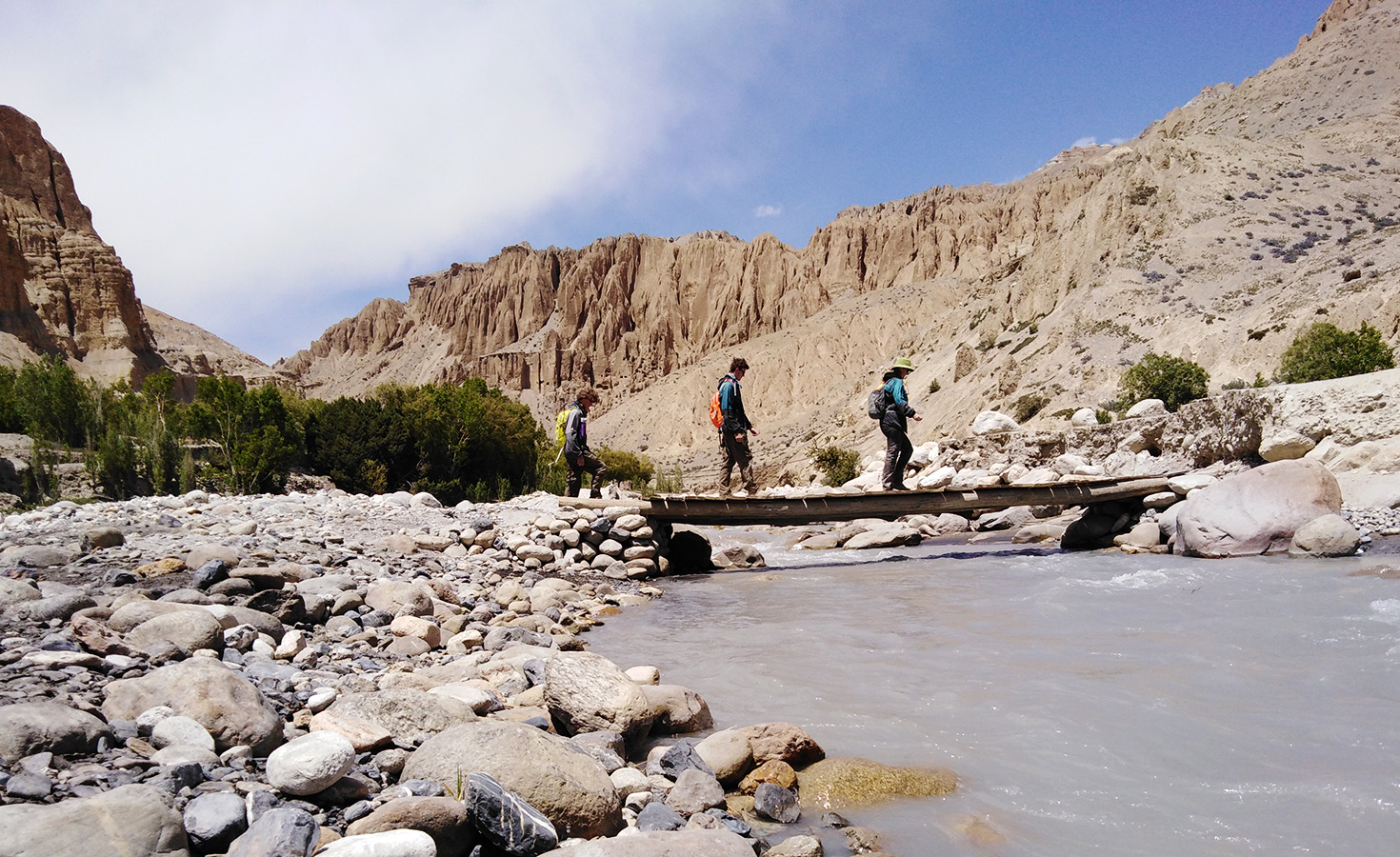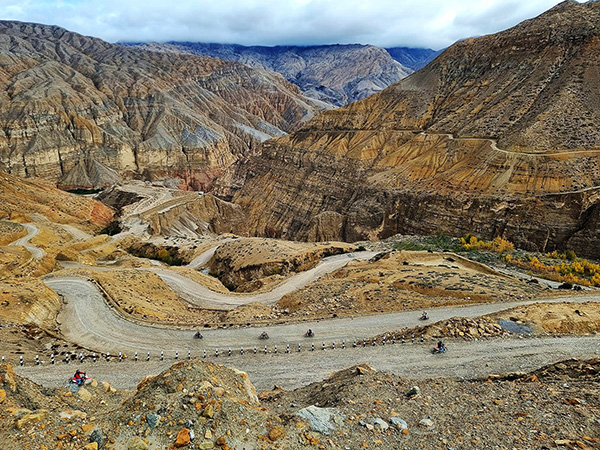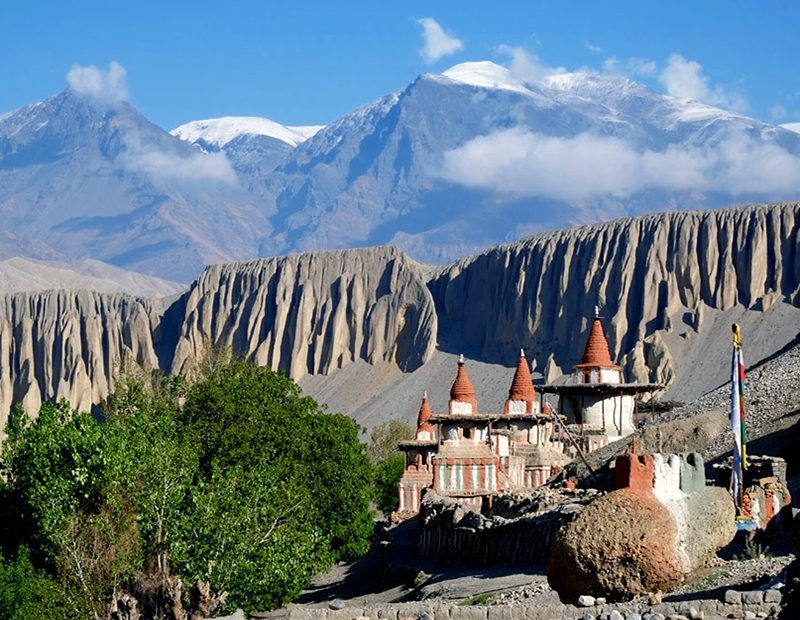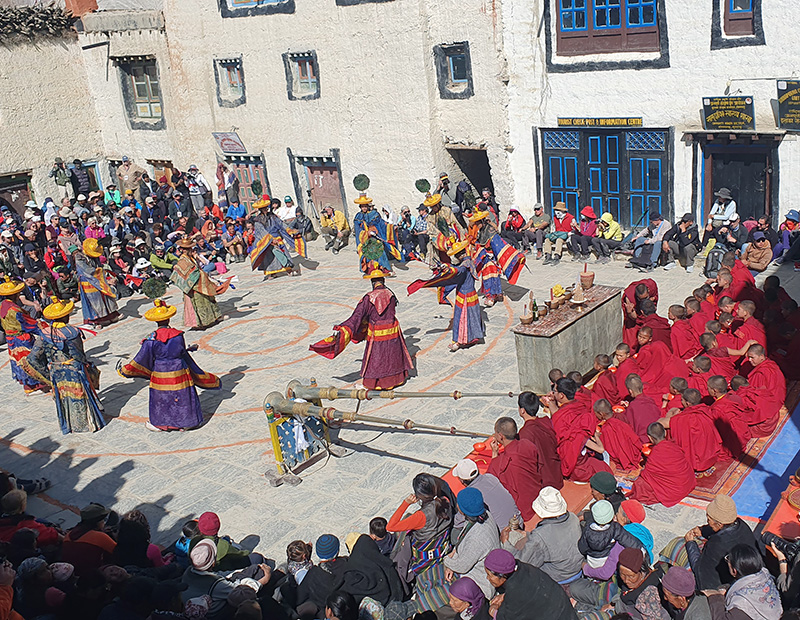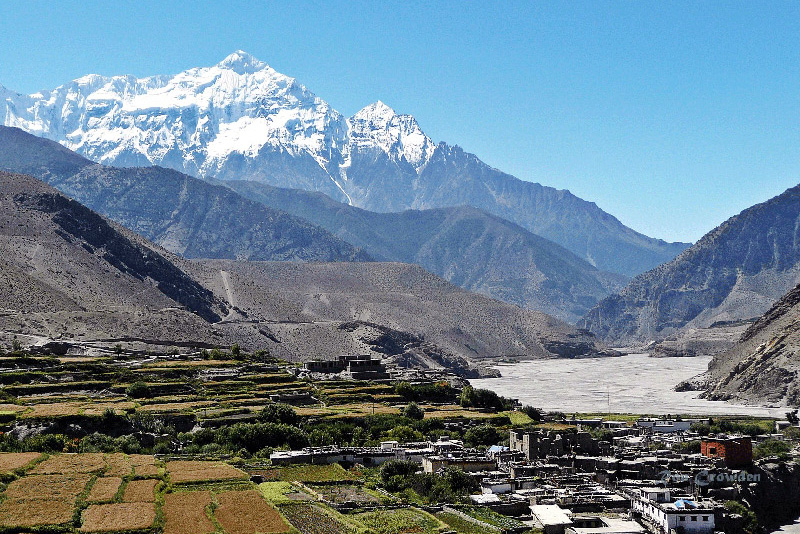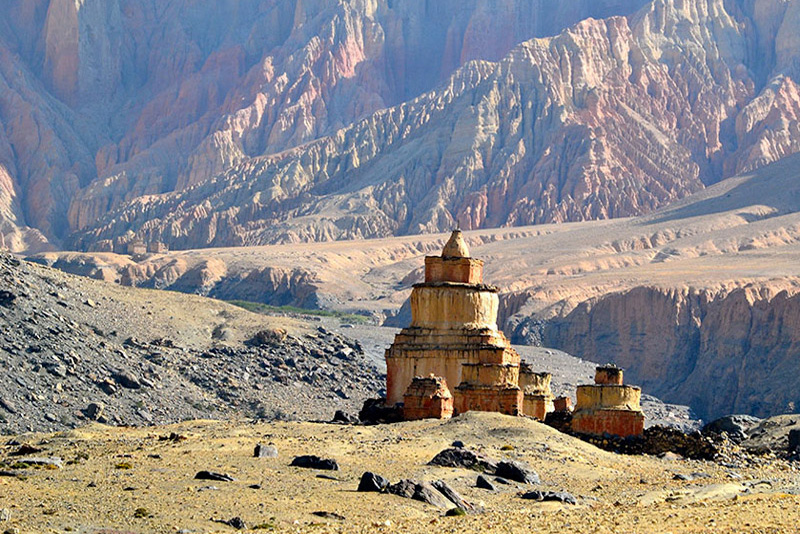Upper Mustang Trek
The Upper Mustang Trek is a captivating journey through the remote and culturally rich region of Upper Mustang in Nepal. Known as the “Kingdom of Lo,” this area offers a unique blend of stunning landscapes, ancient Tibetan Buddhist culture, and distinctive architecture.
Upper Mustang is a restricted Nepalese region. Whoever wishes to visit Mustang must pay a special permission fee and submit an application to any Government-registered trekking company in Nepal. First-time visitors to Mustang will be awoken by the region’s extraordinary beauty and culture. However, your initial visit will not be your last; it will inspire you to return. This region, like the rest of the Himalayas, features breathtaking mountain scenery, highlighted by Dhaulagiri at 8167 meters (26,790 feet) and Annapurna I at 26,000 feet (26,545ft). You will be surrounded by over 35 Mountains taller than 6,000 meters (19,680 feet). The routes ascend from 2,815 meters (9,233 feet) to 3,780 meters (12,390 feet) above sea level.
Lo Manthang was built approximately 1450 by the famous Ame Pal’s son, who conquered and united the Upper Mustang kingdoms. A 300-meter-long, 150-meter-wide, L-shaped wall has acted as protection against bandits, warriors, and ferocious winds. Due to the fact that it has never been extended, archaeologists believe that the settlement has changed little over the past 500 years. 140 dwellings are connected by a few tiny passageways that run beneath the buildings and are home to 1’200 individuals. Monasteries and the palace are by far the largest structures, with the majority of homes being two stories tall.
Upper Mustang Trek Highlights
Upper Mustang is recognized as a mysterious valley and Nepal’s last fo*rbidden kingdom, as well as a “Mini Tibet of Nepal” and a popular journey. Mustang trip, situated in the rain shadow of the Himalayas, is possibly the last bastion of pure Tibetan culture. Because it was forbidden and secluded from the rest of the world, it was able to develop its own rich and distinctive culture and traditions. The historic Kingdom of Lo’s capital, Lo-Mangthang, is a walled city ruled by the holy Mustangi King. Unaffected by contemporary culture, the pace of life in Mustang has remained unchanged for generations. A journey to the kingdom of Mustang is a once-in-a-lifetime event. Here are some of the highlights of the Upper Mustang Trek.
Ancient Walled City of Lo Manthang: Lo Manthang, the capital of Upper Mustang, is a fortified town that retains its medieval charm. The city’s intricate architecture, narrow alleys, and unique monasteries offer a glimpse into its rich history.
Unique Landscapes: The landscapes of Upper Mustang are unlike any other in Nepal. You’ll trek through barren deserts, dramatic cliffs, eroded canyons, and colorful rock formations, creating a surreal and otherworldly environment.
Tibetan Buddhist Culture: Upper Mustang has a strong influence of Tibetan Buddhism, and you’ll encounter ancient monasteries, chortens, prayer flags, and mani walls along the trek. The region is home to many revered monasteries, including the Thubchen Gompa and Chhoser Cave Monastery.
Caves and Cliff Dwellings: The trek takes you past ancient caves and cliff dwellings that were used by monks and villagers for centuries. These caves hold historical and cultural significance.
Tiji Festival: If your trek coincides with the Tiji Festival, you’ll have the incredible opportunity to witness this vibrant and colorful celebration. The festival is a three-day ritual depicting the triumph of good over evil.
Muktinath Temple: The trek begins or ends at Muktinath, a sacred pilgrimage site for both Hindus and Buddhists. The temple complex includes natural water spouts and a beautiful pagoda-style temple.
Stunning Mountain Views: The trek offers panoramic views of the Annapurna and Dhaulagiri ranges, as well as other Himalayan peaks. The rugged landscapes and mountains create a breathtaking backdrop.
Off-the-Beaten-Path: The Upper Mustang Trek is a restricted area, and the limited number of trekkers each year ensures a quieter and more secluded experience compared to more popular trekking routes.
Ancient Trade Routes: The region was historically connected to Tibet through trade routes, and you’ll see remnants of these ancient paths along the way.
Cultural Interaction: Interacting with the hospitable local people provides insight into their traditional way of life, including farming, animal husbandry, and trade.
The Best time for Upper Mustang Trek
The best time for the Upper Mustang Trek is during the post-monsoon autumn season (September to November). This period offers the most favorable weather and trekking conditions for a successful and enjoyable trek. The Upper Mustang Trek is a restricted area, and you’ll need to obtain a special permit to trek in this region. Trekking with a guide or through a reputable trekking agency is highly recommended for safety, cultural understanding, and logistical support. It’s important to approach the trek with respect for local customs and traditions.
When you arrive at Tibhuvan International Airport, our guide will pick you up and take you to your hotel in the bustling Thamel district of Kathmandu. Depending on your arrival time, you can choose to relax for the next journey, see the city’s attractions, or shop for adventure gear in one of Kathmandu’s many adventure supply stores. We’ll assemble our bikes and be ready for the journey in the afternoon.
Early in the morning, we will travel to the beautiful valley of Pokhara via Prithvi Highway. You will see the Western Himalayas during this scenic 6 to 7 hour-long bus ride. Upon arrival you will have the opportunity to explore Pokhara, the beautiful city by the lake. Alternatively, you can go boating in the grand Phewa Lake.
We will catch a plane from Pokhara to Jomsom, one of the main towns in Mustang. It will take around 20 minutes to get there We will fly North-West from Pokhara towards a great portal between Annapurna and Dhaulagiri. You will enjoy beautiful views of the hills and mountains during your flight. From Jomsom, we will trek uphill for 3 hours alongside Kali Gandaki before we reach Kagbeni, the gateway to Upper Mustang. The village is located at the bank of two rivers.
We will continue our journey towards the east bank of the Kali Gandaki climbing through numerous ridges, and then head north for the Tangbe village. This picturesque town is a labyrinth of narrow alleys amid white-washed mud and stone houses, buckwheat fields and apple trees. The majestic Nilgiri dominates the southern sky of Kagbeni. From there, we will hike to Chhusang village for 2 hours before we cross the dwindling Kali Gandaki. We will climb up to a huge red mass of sedimentary rock that had fallen from the cliff above, forming a tunnel through which Kali Gandaki flows. Crossing the Kali Gandaki Valley, we will climb uphill to Chele. You will witness the slow transition in culture, from Manangi culture to Tibetan.
Our trek today goes along a steep barren land, alongside the copper-red canyon. We will make a gradual descent to some Chortens on a ridge, and after hiking downhill for some more time we will reach the beautiful village of Samar. From there, we will climb a ridge and descend into a giant gorge. We will keep trekking through another valley and cross a stream and before we will climb up a ridge which lies at 3,800m. We will climb yet another pass, go through another ridge before we can finally descend to Syangbochen.
From Syangbochen, we will gently hike uphill until we reach a pass at 3770m and trek downhill to reach the village of Geling. From Gheling, we will go uphill passing through fields to the center of the valley. Then we will climb a tough terrain across the head of the valley to the Nyi La pass (3840m). From there we will descend for half an hour until we reach a trail junction, the right trail is a route to Charang while the left one leads to Ghami. It is a village of clustered whitewashed mud and stone houses canopied by an overhanging cliff. This is a great place to spend the night.
We will trek to the driest part of Mustang today. It will be a tiring trek crossing fairly rough terrain. But upon reaching our destination, we will be rewarded with splendid views of the remote countryside, and we will be able to see mountains in all directions. When reaching Charang, a large village at the top of the Charang Chu Canyon, we are due for some rest. On the east of the village, you can find a medieval fort and a red Gompas which house a spectacular collection of statues and thangkas.
We will trek to one of the major attractions on this trip: Lo Manthang. This was the walled capital of the Kingdom of Lo. The city was founded in 1380 by Ame Pal. It consists of around 150 households and residences for lama gurus. We will trek through Lo-Gekar, which is the oldest Gompa in Nepal and older than the Samye Gompa of the Tibet. On reaching the walled city of Lo, you will have the opportunity to visit the ancient temples and monasteries of the region and the periphery of the King’s impressive palace, where the King and Queen of Lo- Manthang reside. You will have the chance to guide horses on a lease and see the beautiful valley.
We will explore the mystical town of Lo-Manthang, starting with a 2-hour visit of the Namgyal Gompa. This beautiful Gompa is situated on a hilltop, which is of high social, religious as well as legal importance as it serves as a local courthouse. After that, we will visit the village of Tingkhar, northwest of Lomanthang with its 40 households. We will also visit Champa Lhakang where you have a chance to admire a large Buddha statue and intricate Mandalas painted on the walls.
We will leave Lo-Manthang taking the upper highland trail. It will reward us with splendid views of Lo-Manthang and the Charang Valley, with snow-capped mountains in the background. We will cross the Dhi Pass at 4,100m and reach Dhamkar.
With Dhaulagiri and Nilgiri among other giants standing tall in the background, we will hike down to Syangbochen. On the way, we pass through Rachen Gompa, mystical Gompa which grew by itself at the lap of a rocky cave.
We will continue our trek over steep ridges and over hills. We will trek to Tetang, the upper village of Chuksang which lies between two hills. It is a safe escapade from the fierce wind that hits the Kali Gandaki valley frequently.
On the last day of this memorable trek, we will pass Jharkot village and visit the local monastery, the grand Tibetan Herbal Medicine Center and see an ancient fortress which once was a palace. During our descent to Jomsom we will enjoy the view of Kali Gandaki Valley and Kagbeni Village. This is the gateway to Mustang.
After taking a 20-minute flight to Pokhara, we will spend the rest of the day in the city to relax.
After breakfast, we will travel back to the capital via Prithvi Highway. Once again the scenic bus ride will keep you refreshed throughout the journey.
Today we will take you to the airport to catch your flight out of Nepal. Alternatively, if you’d like to stay longer, we may make additional travel arrangements to assist you continue your Nepal experience.
- All necessary ground transfers.
- All necessary accommodations as per the itinerary.
- Tea House accommodations during the trek.
- Daily breakfast, lunch and dinner during the trekking.
- All necessary paper works.
- All necessary tre
- kking permits.
- Experienced and First Aid-trained trekking guide.
- Strong, helpful porters.
- Comprehensive medical supplies.
- Trekking map.
- Insurance of all local team.
- Warm clothing and trekking gear for staff.
- Sleeping bag and trip duffle bag.
- Trekking certificate issued by us.
- Welcome and farewell dinner in Kathmandu.
- Nepal Visa fee.
- International flights.
- All meals not mentioned in inclusions.
- Personal expenses not stipulated.
- Optional add-ons.
- Gratuities.
You might also like...
Top Add-on Trips
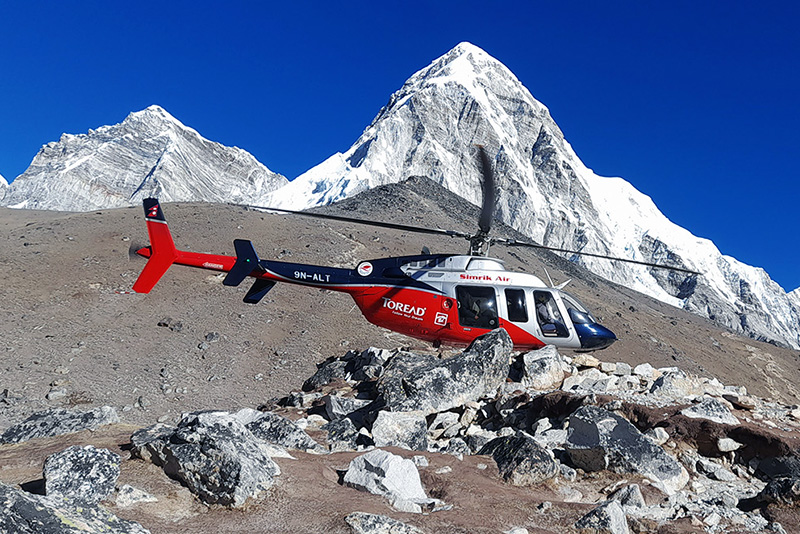
Everest Base Camp Helicopter Tour

Monastery Stay Tour
